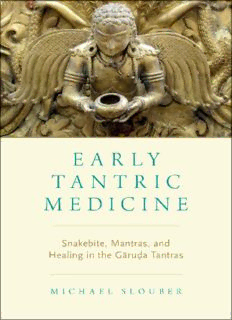
Early Tantric medicine : snakebite, mantras, and healing in the Garuda Tantras PDF
Preview Early Tantric medicine : snakebite, mantras, and healing in the Garuda Tantras
i i “TantricMedicineBook” — 2016/10/20 — 17:00 — page i — #1 i i Early Tantric Medicine i i i i i i “TantricMedicineBook” — 2016/10/20 — 17:00 — page ii — #2 i i i i i i i i “TantricMedicineBook” — 2016/10/20 — 17:00 — page iii — #3 i i Early Tantric Medicine Snakebite, Mantras, and Healing in the Gāruḍa Tantras MICHAEL SLOUBER 1 i i i i i i “TantricMedicineBook” — 2016/10/20 — 17:00 — page iv — #4 i i 3 OxfordUniversityPressisadepartmentoftheUniversityofOxford.Itfurthers theUniversity’sobjectiveofexcellenceinresearch,scholarship,andeducation bypublishingworldwide.OxfordisaregisteredtrademarkofOxfordUniversity PressintheUKandcertainothercountries. PublishedintheUnitedStatesofAmericabyOxfordUniversityPress 198MadisonAvenue,NewYork,NY10016,UnitedStatesofAmerica. ⃝c OxfordUniversityPress2017 Allrightsreserved.Nopartofthispublicationmaybereproduced,storedin aretrievalsystem,ortransmitted,inanyformorbyanymeans,withoutthe priorpermissioninwritingofOxfordUniversityPress,orasexpresslypermitted bylaw,bylicense,orundertermsagreedwiththeappropriatereproduction rightsorganization.Inquiriesconcerningreproductionoutsidethescopeofthe aboveshouldbesenttotheRightsDepartment,OxfordUniversityPress,atthe addressabove. Youmustnotcirculatethisworkinanyotherform andyoumustimposethissameconditiononanyacquirer. Cataloging-in-PublicationdataisonfileattheLibraryofCongress ISBN978–0–19–046181–2 1 3 5 7 9 8 6 4 2 PrintedbySheridanBooks,Inc.,UnitedStatesofAmerica i i i i i i “TantricMedicineBook” — 2016/10/20 — 17:00 — page v — #5 i i i i i i i i “TantricMedicineBook” — 2016/10/20 — 17:00 — page vi — #6 i i i i i i i i “TantricMedicineBook” — 2016/10/20 — 17:00 — page vii — #7 i i Contents ListofFigures viii Preface ix 1. Introduction 1 2. PrecursorstoGāruḍam 19 3. CanonandCompendia 39 4. TheVipatiMantra 57 5. Nīlakaṇṭhaetal. 78 6. SnakebiteGoddesses 89 7. Impact 108 8. ConclusionsandProspective 129 Appendices A. ProloguetotheTranslationandEdition 133 B. TranslationoftheKriyākālaguṇottara:TheGāruḍamChapters 142 C. EditionoftheKriyākālaguṇottara:TheGāruḍamChapters 188 Notes 280 RegisterofShortenedInternetLinks 330 TitleListofIndicPrimarySources 332 GeneralBibliography 340 Index 354 i i i i i i “TantricMedicineBook” — 2016/10/20 — 17:00 — page viii — #8 i i Figures 3.1 Sadāśiva’sfive-facedform 44 4.1 TheHandofGaruḍa 66 4.2 Protectingthevitalforce 71 6.1 AKurukullāyantra 101 6.2 ASuvarṇarekhāyantra 106 A.1 Stemmaofmanuscriptrelationships 137 i i i i i i “TantricMedicineBook” — 2016/10/20 — 17:00 — page ix — #9 i i Preface my work on thisbookbeganin2005inagraduateseminaronreading Sanskrit manuscripts. Eager to test my new skills on fresh material, I had brought a list of potential manuscripts to Dr. Somadeva Vasudeva, then a visitingfacultymemberatUCBerkeley.Skimmingthelist,henoticedone titled Kriyākālaguṇottara and told me with full confidence to order copies of all of its manuscripts. His former mentor at Oxford, Professor Alexis Sanderson,hadpositivelyidentifieditasthesametextquotedbyKṣemarāja inhiseleventh-centuryadcommentaryontheNetraTantra.Inotherwords, here was an early Hindu Tantra important enough to be read and cited bythelearneddiscipleoffamedKashmirianpolymathAbhinavagupta,and one that was yet unknown to modern scholarship. It took several years of diligent study for me to realize the true importance of this work to the history of Indian medicine and religion. Set in the voice of the Hindu god Śiva, the text preserves rich medical and religious material from two of the five classes of his Tantric revelation. Leading scholars had deemed thesemedicalTantraslost,butmyworkwiththeKriyākālaguṇottaraledto the discovery of several other original texts surviving in fragile palmleaf manuscriptsinNepal. Before proceeding further, some clarification of the word “Tantra” is necessary. Indeed, in the popular imagination as well as in the minds of many scholars, Tantra is a religious tradition associated with depraved sexual practices and intentionally transgressive ritual involving the most impure substances. This mistaken portrait of Tantra derives partly from modern Indian usage of the word as a pejorative referring to sorcery and secret rites. Many scholars would distinguish between Āgama, the respectablerevelationsofŚivaconcerningnormativetempleworship—still valuedinSouthIndia—andthemoreorlesstransgressiveTantrasconcerned withwildfemaledeities,andthepowersthattheygranttoaspirantssecretly worshippingincremationgrounds.Suchadivisiondidcomeaboutinthe i i i i
Description: